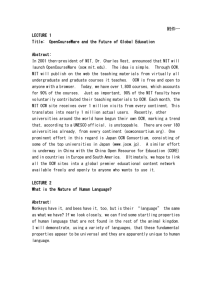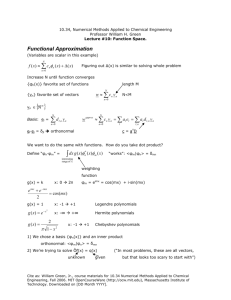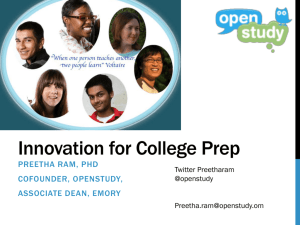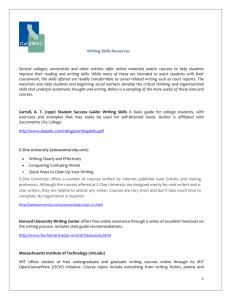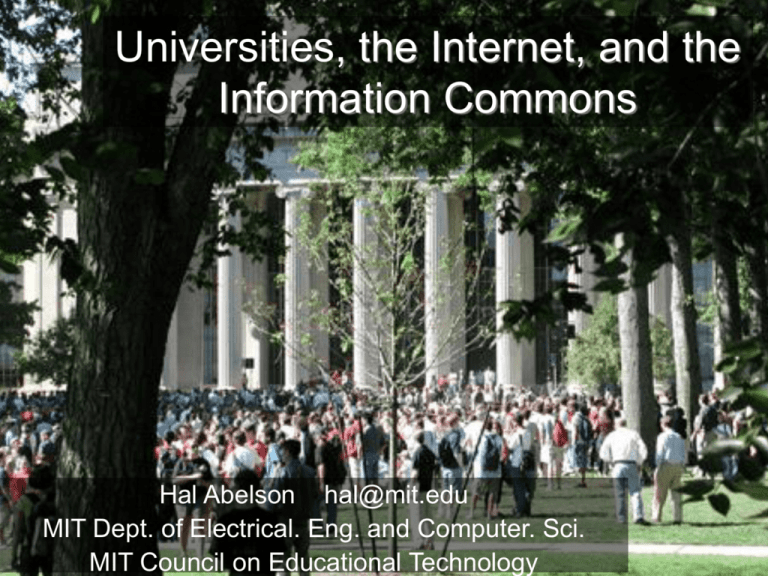
Universities, the Internet, and the
Information Commons
Hal Abelson hal@mit.edu
MIT Dept. of Electrical. Eng. and Computer. Sci.
MIT Council on Educational Technology
• Question: How is the
Internet going to be used in
education, and what is your
university going to do about
it?
• An answer from the MIT
Faculty is this: Use it to
provide free access to the
primary materials for
virtually all our courses. We
are going to make our
educational material
available to students,
faculty, and other learners,
anywhere in the world, at
any time, for free.
MIT President Charles Vest
President’s Report, Fall 2001
2
• The concept, as announced April 2001
– MIT will put all its course content,
undergraduate and graduate, into Web-based
format
– The OCW Website will be open and freely
available to the world
– MIT will commit to OCW as a permanent,
sustainable activity
– Plan: 50-course pilot for Sept. 02. Commitment
to have 500 courses published by Sept. 03.
3
Site Highlights
4Syllabus
4Course Calendar
4Lecture Notes
4Assignments
4Exams
4Problem/Solution Sets
4Labs and Projects
4Hypertextbooks
4Simulations
4Tools and Tutorials
4Video Lectures
4
Legal fine print
• Participation by faculty is
voluntary
• Faculty retain copyright,
but grant MIT an
irrevocable nonexclusive
license to include their
material in OCW
• MIT publishes OCW under
a Creative Commons
license
– Attribution
– Noncommercial
– Share-alike
5
OCW Site Traffic
MIT OCW Monthly Traffic (since 10/1/03)
6
Traffic by Geographic Region (in
Web hits, since 10/1/03)
13.9 M
137.2 M
50.4 M
7.8 M
Region
North America
East Asia
Western Europe
South Asia
Latin America
Eastern Europe
and Central Asia
MENA
Pacific
Sub-Sahar.
Africa
TOTAL HITS
Hits Since
Hit %
10/1/03
137,154,920 43.5
61,706,485 19.6
50,372,337 16.0
19,558,358
6.2
17,826,440
5.7
13,942,007
4.4
7,748,165
4,249,296
2.5
1.3
2,551,284
0.8
61.7 M
19.6 M
2.6 M
17.8 M
4.3 M
315,109,292
7
Countries with most hits in October
2004 (outside of U.S.)
Country
Web Hits
Country
Web Hits
1
China
2,127,727
11 Japan
559,389
2
India
1,919,088
12 Turkey
480,554
3
Taiwan
1,760,944
13 Spain
440,210
4
1,337,334
14 Pakistan
413,360
1,026,644
15 Singapore
411,290
6
Canada
United
Kingdom
South Korea
16 Australia
383,359
7
Germany
717,634
17 Czech Republic
364,671
8
France
665,014
18 Netherlands
313,102
9
Brazil
587,039
19 Mexico
301,440
20 Vietnam
279,080
5
10 Italy
954,124
576,179
8
Traffic from 3200 universities, colleges (since
10/1/03)
University
Visits
Natl. Univ. of
Singapore
11,245
2
National Taiwan
Univ.
10,816
3
Harvard University
5,915
4
Stanford University
3,334
5
Georgia Tech Univ.
3,175
6
Purdue University
3,154
7
Columbia
University
3,046
8
University of
Michigan
2,976
9
Univ. of Illinois at
Champaign-Urbana
2,884
National Chiao
Tung Univ.
(Taiwan)
2,812
1
10
University
Visits
11 Cambridge University
2,750
12
Texas A&M
University
2,747
13 Cornell University
2,730
14
Univ. of California
at Berkeley
2,683
15
University of
Southern California
2,498
16 Univ. of Washington
2,407
17 Boston University
2,406
18 University of Texas
2,369
19 Univ. of Pennsylvania
2,283
20
Carnegie Mellon
Univ.
2,278
User profiles
› 55% of educators teach
4%
13%
at 4-year colleges or the
equivalent
Educators
› 49% of educators have
less than five years
teaching experience
Self-learners
Students
31%
52%
OCW Use data
Use Scenario
% of Use
Planning, developing or teaching a course
36%
Enhancing personal knowledge
22%
Planning curriculum
10%
Other
32%
Complementing a subject currently taking
43%
Enhancing personal knowledge
40%
Planning future course of study
10%
Other
7%
Enhancing personal knowledge
81%
Learning subject matter—course not available for
study
9%
Planning future course of study
8%
Other
2%
5.7% response rate on
21,500 surveys
11
OCW Recognition
January 29, 2003
October 15, 2003
October 21, 2003
November 10, 2003
Kyoto (Japan) Digital
Microsoft Internet
Mass. Interactive
InfoWorld 100
Archive Project
Biz Solution of Year
Media Council (2)
Award
June 7, 2004
September 29, 2004
October 18, 2004
ComputerWorld
Digital Education
MarCom Creative
Honors Program
Achievement Award
Awards (2)
CERTIFIED
………………………
Business Solutions
Partner
April 20, 2004
The Webby Awards
12
OCW Translations
• 60 courses in Spanish and Portuguese
through Universia.net partnership
• Individual courses in 10 languages
• Extensive translation efforts beginning in
China and Taiwan
13
Other OCWs are beginning to appear
• Some using MIT materials,
some using the format,
some using the idea
14
OpenCourseware:
Alignment with MIT Core Values
• Commoditizing the “content” sharpens our
focus on the substantive values of
residential education: personal attention
from faculty and participation in learning
and research communities
• “Giving it away” helps defuse complex
intellectual property issues of ownership
and control that can distract the university
from its mission to disseminate knowledge
15
DSpace
• Vision
– A federated repository that makes available the
collective intellectual resources of the world's leading
research institutions
• Mission
– Create a scalable digital repository that preserves and
communicates the intellectual output of MIT's faculty
and researchers
– Support adoption by and federation with other
institutions
• Implemented by MIT Libraries staff working
together with Hewlett-Packard Laboratories and
the World Wide Web Consortium
16
17
18
19
20
21
22
23
Range of DSpace content at MIT
•
•
•
•
•
•
Preprints, articles
Technical reports
Working papers
Conference papers
Theses
Datasets
– Statistical, geospatial,
biological, etc.
• Images
– Visual, scientific, etc.
• Audio and video
recordings of
lectures, and other
multimedia objects
• Learning objects
• Reformatted digital
library collections
DSpace will be the archive for
OpenCourseWare
24
DSpace Technology
• Open-source implementation, freely
available
• A digital library standard and architecture
including:
– Metadata based on Web Consortium’s RDF
– Access control
– Collection management tools
– Federation architecture
25
DSpace Federation
• Initial partners with MIT are Cambridge,
Columbia, Cornell, Ohio State, and Universities
of Rochester, Toronto, and Washington
• Will help drive DSpace development
– Content to test interoperability
– Digital preservation expertise
• Federation plan and governance structure being
developed with funding from the Mellon
Foundation
• Beyond the Federation, about 140 known
DSpace adopters, over 10,000 downloads of
DSpace software
26
27
28
29
30
31
32
33
34
MITOPENCOURSEWARE
MASSACHUSETTS INSTITUTE OF TECHNOLOGY
Two coordinated initiatives to
strengthen the information commons
35
Companion visions
• OpenCourseWare vision: Global access to
the raw material from which the world’s
great learning institutions create
educational experiences for their students
• DSpace vision: Global access to the
collective intellectual resources of the
world’s leading research institutions
through a federation of institutional
archives
36
Why should universities build repositories
like DSpace and OpenCourseWare?
• To help pursue our mission as
institutions of higher education and
scholarly research.
37
From MIT’s Mission Statement
The mission of MIT is to advance
knowledge and educate students in
science, technology, and other areas of
scholarship that will best serve the nation
and the world in the 21st century.
The Institute is committed to generating,
disseminating, and preserving
knowledge, and to working with others to
bring this knowledge to bear on the
world's great challenges.
38
Fundamental Questions about the
Role of the Institution
• OpenCourseWare: What should be the
university’s institutional role in disseminating
and preserving our educational
contributions?
• DSpace: What should be the university’s
institutional role in preserving and
disseminating our educational and our
research contributions?
39
Why should universities build repositories
like DSpace and OpenCourseWare? (2)
• To help pursue our mission as institutions of
higher education and scholarly research.
40
Why should universities build repositories
like DSpace and OpenCourseWare? (2)
• To help pursue our mission as institutions of
higher education and scholarly research.
• Without initiatives like these, traditional
academic values will be increasingly
marginalized, and university communities
will be increasingly stressed.
41
University of Southern
California
As an academic institution, USC's purpose is to
promote and foster the creation of intellectual
property. It is antithetical to this purpose for USC to
play any part, even inadvertently, in the violation of
the intellectual property rights of others.
September 2002, letter to USC students from the Dean of
Libraries
42
University of Chicago
The creation and dissemination of knowledge is a collective
enterprise at a university. ... Even when faculty members
teach a class that they have prepared at home with their own
materials, the work is itself supported by the salary the faculty
members enjoy and all the other support—intellectual,
financial, logistical, and otherwise—that the University
provides. ...
For this reason, we recommend that the University
formally implement the principle that the University owns the
intellectual property the faculty create at the University or with
substantial aid of its facilities or its financial support.
Approved by the Council of the University
Senate on April 27, 1999.
43
Many students probably create a work that would infringe a
faculty member's copyright, that is, they base their notes on
and incorporate her particular expression rather than just
state facts and ideas she articulates in more detail. Faculty
members have always permitted this kind of activity without
actually talking about it. They “implicitly” license students to
create a “derivative work” from the lecture. The license is
implied through academic tradition -- students are expected
to take notes. …
Now faculty may wish to make the implied license explicit and
add some restrictions.
A limited license to take notes could be very important to
protecting the intellectual content of lecture materials …
University of Texas, Office of the General Counsel, August 2001
http://www.utsystem.edu/ogc/intellectualproperty/lectures.htm
>
44
The suggested license …
Written and verbal instructions at the beginning of class could
look something like this:
My lectures are protected by state common law and federal
copyright law. They are my own original expression and I
record them at the same time that I deliver them in order to
secure protection. Whereas you are authorized to take notes
in class thereby creating a derivative work from my lecture,
the authorization extends only to making one set of notes for
your own personal use and no other use. You are not
authorized to record my lectures, to provide your notes to
anyone else or to make any commercial use of them without
express prior permission from me.
University of Texas, Office of the General Counsel, August 2001
http://www.utsystem.edu/ogc/intellectualproperty/lectures.htm
45
Conflating “freedom of inquiry” with
“freedom of property”
Intellectual property law … embodies the notion
that the only forms of cultural work that can be
“protected” are those that can be owned. …
… the conflation of property rights and “academic
rights” participates in a set of discourses … in
which freedom can only be understood to mean
“individual free enterprise.”
In retelling this tale academics risk losing a
language for talking about knowledge as other than
private property and the university as other than
economically “useful.”
Corynne McSherry, Who Owns Academic Work? (2001)
46
Why should universities build repositories
like DSpace and OpenCourseWare? (3)
• To help pursue our mission as institutions of
higher education and scholarly research.
• Without initiatives like these, traditional
academic values will be increasingly
marginalized, and university communities
will be increasingly stressed.
47
Why should universities build repositories
like DSpace and OpenCourseWare? (3)
• To help pursue our mission as institutions of
higher education and scholarly research.
• Without initiatives like these, traditional
academic values will be increasingly
marginalized, and university communities
will be increasingly stressed.
• To keep a seat at the table in decisions
about the disposition of knowledge in the
information age.
48
Challenges to universities from the
“propertization” of scientific publication
• Cost
• Imposition of arbitrary, inconsistent rules
• Impediments to new tools that could aid
scholarly research
• Danger of monopoly ownership and
control of the scientific literature
49
50
If people were asked to sign a petition to
do away with paying tax, many would sign.
But they then might be the first to complain
about deteriorating infrastructure and
lower standards of public service. The
publication of research is a serious
business yet only costs a fraction of the
funding of that research.
Robert Campbell, President
Blackwell Science, Ltd.
51
Scientific literature as property:
The basic deal
• Scientist authors give their property away to the
journal publishers.
• Publishers own this property and all rights to it
forever, and they magnanimously allow the
scientist author to retain some limited rights that
are determined at the publisher’s sole discretion.
• The university generally gets no specific rights.
• And the public doesn’t enter into this deal at all.
52
Some rights generously granted to
authors by the Association for
Computing Machinery
• the right to reuse any portion of the work, without
fee, in future works of the author's own,
including books, lectures and presentations
• the right to revise the work
• the right to post author-prepared versions of the
work … in a personal collection on their own
Home Page and on a publicly accessible server
of their employer. Such posting is limited to
noncommercial access and personal use by
others …
ACM COPYRIGHT POLICY, Version 4 Revised 11/01/02
www.acm.org/pubs/copyright_policy/
53
Some rights generously granted to
authors by Elsevier
• the right to include the article in full or in part in a
thesis or dissertation (provided that this is not to
be published commercially)
• the right to present the article at a meeting or
conference and to distribute copies of such
paper or article to the delegates attending the
meeting;
• the right to prepare other derivative works, to
extend the article into book-length form, …
• the right to post a revised personal version of the
text of the final article … on the author's
personal or institutional web site or server
54
authors.elsevier.com - 2004
Some rights generously granted to
authors by the Journal of the
American Chemical Society
• Authors may distribute or transmit their
own paper to not more than 50 colleagues
• Authors may post the title, abstract (no
other text), tables, and figures from their
own papers on their own Web sites
paragon.acs.org - 2004
55
and from the
New England Journal of Medicine…
The Massachusetts Medical Society is the owner of
all copyright to any work published by the Society. …
The Society and its licensees have the right to use,
reproduce, transmit, derive works from, publish, and
distribute the contribution, in the Journal or
otherwise, in any form or medium. Authors will not
use or authorize the use of the contribution without
the Society’s written consent, except as may be
allowed by U.S. fair-use law.
56
authors.nejm.org/Misc/MsSubInstr.asp - 2004
We make this deal because …
Maintaining the integrity of the publication
process is vital, be it in print or online. … It is
not a process that should be ceded to
unknown individuals … Copyright should not
be ceded to individual authors who would not
be able to undertake the job of protecting
their work from the introduction of errors.
Ira Mellman, Editor, Journal of Cell Biology
57
What’s valuable for promoting the
progress of science?
• Quality publications and a publication process with
integrity, certainly. But also …
• Open, extensible indexes into publications
• Automatic extraction of relevant selections from
publications
• Automatic compilation of publication fragments
• Static and dynamic links among publications, publication
fragments, and primary data
• Data mining across multiple publications
• Automatic linking of publications to visualization tools
• Integration into the semantic web
• And hundreds of things no one has thought of yet
58
evil
59
60
61
Will sophisticated research tools
• Be stillborn by limited access to quality
sources?
• Or
• Stimulate network effects that lead to
further concentration and monopolization
of the scientific literature?
62
One publisher’s view
We aim to give scientists desktop access
to all the information they need, for a
reasonable
price,talking
and to ensure
that the
We are
about
value of the content and the context in
private
monopoly
control
which it is presented are reflected in the
information
The information
of theprovision.
scientific
record. is
made available to researchers under
licenses accorded to their institutes, and
they have all the access they wish.
63
promoting the
progress of science
and the useful arts
production
quality assurance
creation
dissemination
review
selection
preservation
authoritative source
new access tools
indexing
data mining
Institutional players
jockeying for influence
and control
Professional
For-profit
societies
publishers
Non-profit
…
publishers
Will universities
have a seat at
the bargaining
table?
64
promoting the
progress of science
and the useful arts
production
quality assurance
creation
dissemination
review
selection
preservation
authoritative source
new access tools
indexing
data mining
Institutional players
jockeying for influence
and control
Professional
For-profit
societies
publishers
Non-profit
…
publishers
Will creators
have a seat at
the bargaining
table?
65
66
67
Copyright law makes it difficult to
build on each other’s work
©
all rights
reserved
public domain:
no rights reserved
might not be the right choice for all
of the people all of the time.
This is the default.
might be the right choice for some
of the people some of the time.
This is surprisingly hard to do.
controlled sharing:
might be the right choice for more
some rights reserved of the people more of the time.
This requires lawyers to write and
interpret licenses.
68
69
70
<rdf:RDF xmlns="http://web.resource.org/cc/"
xmlns:dc="http://purl.org/dc/elements/1.1/"
xmlns:rdf="http://www.w3.org/1999/02/22-rdf-syntax-ns#">
<Work rdf:about="">
<dc:type rdf:resource="http://purl.org/dc/dcmitype/Text" />
<license rdf:resource="http://creativecommons.org/licenses/by-nc-sa/1.0/" />
</Work>
<License rdf:about="http://creativecommons.org/licenses/by-nc-sa/1.0/">
<permits rdf:resource="http://web.resource.org/cc/Reproduction" />
<permits rdf:resource="http://web.resource.org/cc/Distribution" />
<requires rdf:resource="http://web.resource.org/cc/Notice" />
<requires rdf:resource="http://web.resource.org/cc/Attribution" />
<prohibits rdf:resource="http://web.resource.org/cc/CommercialUse" />
<permits rdf:resource="http://web.resource.org/cc/DerivativeWorks" />
<requires rdf:resource="http://web.resource.org/cc/ShareAlike" />
</License>
71
</rdf:RDF>
72
73
74
75
76
Copyright licenses for people who understand that
innovation and new ideas come from building off
exisiting ones.
77
78
79
Summary
• Universities have core institutional reasons
to support the information commons
• Universities can establish institutional
mechanisms that support the information
commons.
• Everyone can support the commons by
using Creative Commons licenses
80
END
81
Universities, as institutions, pre-date the
“information economy” by many centuries and
are not for-profit cultural entities, whose reason
for existence (purportedly) is to discover truth,
codify it through techniques of scholarship, and
then teach it.
Universities are meant to pass the torch of
civilization, not just download data into student
skulls, and the values of the academic
community are strongly at odds with those of all
would-be information empires…
Universities do not merely “leak information” but
vigorously broadcast free thought.
Bruce Sterling, The Hacker Crackdown (1992)
82
83



